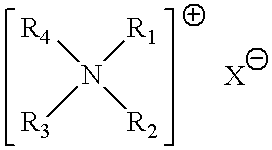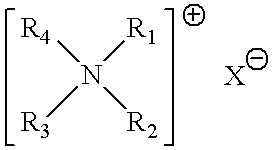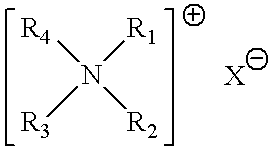Liquid Laundry Treatment Composition Comprising An Asymmetric Di-Hydrocarbyl Quaternary Ammonium Compound
- Summary
- Abstract
- Description
- Claims
- Application Information
AI Technical Summary
Problems solved by technology
Method used
Image
Examples
examples
[0103]Examples I-IV
Single Compartment Liquid Unit Dose Pouch, About 10 Grams in Weight
PVOH Film Used is Monosol M8630 at 3 mil Thickness.
[0104]
Example I:Example II:Example III:IngredientWt. %Wt. %Wt. %Arquad HTL8-MS40.040.050.0Branched Anionic Surfactant2.42.42.0(Neodol 23-9)Alcohol Ethoxylate 1.8S1.31.30Glycerin15.015.010PEG40023.5252.0Perfume5.32.55Perfume Microcapsules01.00Dye0.20.20.2HCl0.80.80.8Water11.511.810.0Solvent (Glycerine Carbonate)0020IngredientExample IV: Wt. %Arquad HTL8-MS10.0Linear alkylbenzene sulfonic acid5.0Alkyl ethoxylates50.8Alkylamidopropyl amine3.3Citric acid3.2Chelant (DTPA)0.3Amine ethoxylate polymers3.71,2-propanediol9.0Monoethanolamineto pH 8.0Enzyme (Protease)1.8Enzyme (Amylase)0.4Enzyme (Lipase)0.1Formic acid1.0Calcium and sodium formate0.5Fluorescent whitening agent0.25Dye0.002Perfume5.0WaterBalance
example v
Dual Compartment Liquid Unit Dose Pouch
[0105]
IngredientExample V: Wt. %First compartment - 10 gramsArquad HTL8-MS40.0Neodol 23-92.4Glycerin15.0PEG40024.8Perfume5.3Dye0.2HCl0.8Water11.5Second compartment - 50 gramsLinear alkylbenzene sulfonic acid5.0Alkyl ethoxylates50.8Alkylamidopropyl amine3.3Citric acid3.2Chelant (DTPA)0.3Amine ethoxylate polymers3.71,2-propanediol17.5Monoethanolamineto pH 8.0Enzymes2.3Formic acid1.0Calcium and sodium formate0.5Fluorescent whitening agent0.25Dye0.002WaterBalance
example vi
Two Compartment Powder / Liquid Unit Dose Pouch
[0106]
IngredientExample VI: Wt. %First compartment - 10 gramsArquad HTL8-MS45.0Glycerin15.0PEG40024.5Perfume3.0Dye0.2HCl0.8Water11.5Second compartment - 50 gramsTide Free Powder detergent99.0Perfume Microcapsules1.0
[0107]It should be understood that every maximum numerical limitation given throughout this specification includes every lower numerical limitation, as if such lower numerical limitations were expressly written herein. Every minimum numerical limitation given throughout this specification includes every higher numerical limitation, as if such higher numerical limitations were expressly written herein. Every numerical range given throughout this specification includes every narrower numerical range that falls within such broader numerical range, as if such narrower numerical ranges were all expressly written herein.
[0108]All parts, ratios, and percentages herein, in the Specification, Examples, and Claims, are by weight and all ...
PUM
 Login to view more
Login to view more Abstract
Description
Claims
Application Information
 Login to view more
Login to view more - R&D Engineer
- R&D Manager
- IP Professional
- Industry Leading Data Capabilities
- Powerful AI technology
- Patent DNA Extraction
Browse by: Latest US Patents, China's latest patents, Technical Efficacy Thesaurus, Application Domain, Technology Topic.
© 2024 PatSnap. All rights reserved.Legal|Privacy policy|Modern Slavery Act Transparency Statement|Sitemap



